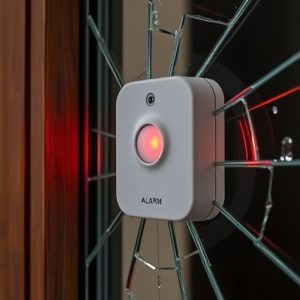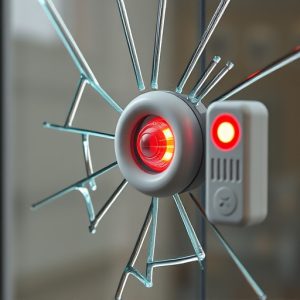Securing Your Premises: The Science and Installation of Glass Break Alarm Sensors
Glass break alarm sensors are an essential component of modern security systems, adept at detecting …….
Glass break alarm sensors are an essential component of modern security systems, adept at detecting the sound of breaking glass and alerting authorities or occupants swiftly. These sensors use sophisticated algorithms to differentiate between the acoustic signatures of glass impact and general noise, employing microphone technology to capture and analyze sound waves against a reference library to confirm an incident. They are indispensable for safeguarding homes, businesses, and high-security facilities like data centers and financial institutions, and also serve environments that demand acoustic tranquility, such as libraries or recording studios. The technology showcases advancements in audio signal processing, offering precise and reliable protection tailored to various settings. These sensors are typically installed near windows and connected to an alarm system's control panel, with the ability to adapt over time through machine learning to reduce false alarms. They often come with additional features like pet immune settings and compatibility with other smart home technologies for enhanced convenience and security. Investing in a reputable glass break alarm sensor ensures a specialized layer of protection that complements traditional security measures.
Explore the intricacies of glass break alarm sensors, pivotal components in fortifying your home’s security. This article demystifies their detection mechanisms and diverse applications, delves into the science behind their advanced technology, and guides you through the process of installing these systems. Additionally, we compare top-rated models on the market, aiding you in selecting the best glass break alarm system to suit your needs. Enhance your safety protocols with knowledge tailored for discerning homeowners and security enthusiasts alike.
Understanding Glass Break Alarm Sensors: Detection Mechanisms and Applications
Glass break alarm sensors are a critical component in security systems designed to detect the sound of breaking glass, thereby alerting occupants and authorities to potential intrusions or hazards. These sophisticated devices utilize advanced algorithms that can distinguish between the frequencies produced by the impact of a projectile on glass and ambient noise. When activated, they trigger an alarm, providing immediate response capability. The detection mechanism typically involves a microphone that captures sound waves; the sensor then analyzes these waves against a pre-recorded database of glass breakage sounds to accurately identify when glass has been broken. This technology is integral in safeguarding homes, commercial properties, and sensitive locations such as data centers and financial institutions. Its applications extend beyond security, as it can also be used for acoustic monitoring in environments where silence or quiet soundscapes are crucial, such as libraries, recording studios, or during sensitive events. The integration of glass break alarm sensors is a testament to the strides made in audio signal processing and their role in enhancing safety and security measures. They represent a non-invasive means of protection that requires minimal disruption to property aesthetics, making them an attractive solution for both residential and commercial sectors.
The Science Behind Glass Break Alarm Technology: How It Works
Glass break alarm systems are sophisticated acoustic sensors designed to detect the sound patterns associated with breaking glass, thereby providing an immediate auditory and visual alert upon sensing this specific frequency of vibration. These systems utilize advanced signal processing algorithms capable of distinguishing between the sound of glass fracturing and other noise. When a sudden change in acoustic pressure occurs, which is characteristic of glass breakage, the sensor captures and analyzes the sound wave frequencies. It identifies the unique spectral characteristics that are consistent with glass breaking. The alarm is then triggered, creating a deterrent effect against intruders and ensuring prompt security response.
The technology behind glass break alarm sensors is rooted in the science of acoustics and signal processing. These sensors are typically composed of an array of microphones that are strategically placed to cover various areas within their range. They employ algorithms that are trained to recognize the sound profile of glass shattering, which typically involves a series of high-frequency harmonics that are distinct from other common sounds. The sensor’s software is optimized to filter out irrelevant noise and focus on these specific frequency patterns. This selective sensitivity allows for a low false alarm rate, ensuring that only genuine threats activate the alarm. The integration of machine learning techniques further enhances the system’s accuracy over time, as it can adapt to different environmental conditions and reduce the likelihood of nuisance alarms.
Installing a Glass Break Alarm Sensor: A Step-by-Step Guide
When securing your property, a glass break alarm sensor offers an additional layer of protection beyond traditional door and window sensors. These sophisticated devices are designed to detect the sound frequencies emitted when glass is broken, thereby alerting you or authorities immediately. Installing a glass break alarm sensor involves several key steps to ensure its effectiveness and accuracy. Begin by selecting a suitable location with optimal acoustic properties; typically, this would be near windows or other potential points of entry. Adhere the sensor to a flat, solid surface away from corners to minimize false alarms from echoes or reflections. Next, connect the sensor to the central control panel of your alarm system, following the manufacturer’s wiring diagram and instructions precisely.
Once installed, configure the settings on your alarm system to include the glass break detection feature. This often involves programming specific sound frequency parameters that align with common glass types used in your region. Test the system by simulating a window breakage from a distance comparable to an actual intrusion attempt. Ensure that the alarm activates only when glass is broken, not when other sounds are present. Calibrating and testing the sensor regularly will help maintain its sensitivity and reliability over time. Remember to keep the sensor clean and free of dust or debris that could interfere with its functionality. By following these installation and maintenance steps, you can effectively integrate a glass break alarm sensor into your home security system, enhancing the protection of your premises.
Comparing Glass Break Alarm Systems: Features, Benefits, and Best Models on the Market
When securing residential or commercial properties, the integration of a glass break alarm sensor plays a pivotal role in enhancing safety and deterring intruders. These sophisticated sensors are engineered to detect the sound frequency typical of glass breaking, triggering an immediate alert that can signal authorities and occupants. Unlike traditional motion detectors, glass break sensors provide a unique layer of security by specifically monitoring for the distinctive acoustic patterns generated when glass is shattered or fractured.
Choosing the most suitable glass break alarm system requires careful consideration of features and benefits tailored to individual needs. Top-of-the-line models boast advanced algorithms that minimize false alarms while ensuring rapid response times. They often come with pet immune functions, allowing pets up to a certain weight to move around without triggering the alarm. Additionally, these systems are frequently integrated with other smart home devices, offering seamless connectivity and centralized control via mobile apps or voice commands. When exploring options, it’s beneficial to assess models like those from brands known for their reliability and innovation in security technology. These best-in-class systems often feature high-fidelity microphones and wide detection zones, making them highly effective in a variety of environments. Homeowners and businesses alike can rest assured knowing that these sophisticated glass break alarm sensors are an indispensable component of a comprehensive home or building security system.


